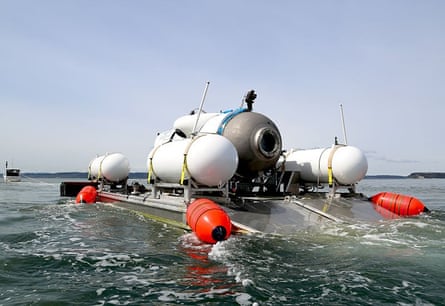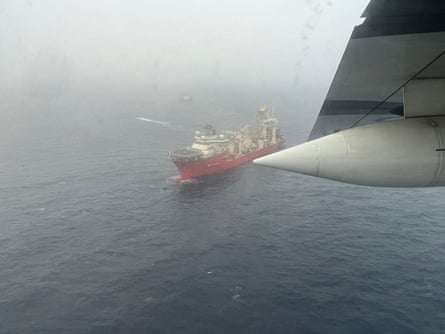The search for a submersible that went missing during a dive to the wreck of Titanic has entered its fourth day, amid concerns the oxygen supply sustaining its five passengers is running dangerously low.
Equipment from the US, Canada, UK and France is heading to the scene of the search, about 640km (400 miles) south of St John’s, Newfoundland, joining an international coalition of rescue teams that is sweeping a vast expanse of the North Atlantic for the Titan after it went missing on Sunday, nearly two hours into its dive.
Officials still hold out hope of a rescue. A US Coast Guard captain, Jamie Frederick, said on Wednesday: “When you’re in the middle of a search-and-rescue case, you always have hope.” Joyce Murray, Canada’s coast guard minister, echoed that sentiment. “We have to retain hope as part of what we are doing as a human community to find the explorers and bring them to safety,” she said.
The search is focused on an area where underwater sounds have been heard but their origin remains a mystery. “I can’t tell you what the noises are. What I can tell you is we’re searching where the noises are, and that’s all we can do at this point,” Frederick said, adding that recordings were being analysed by navy subsurface acoustics experts.

As of Wednesday night local time, remotely operated deep-sea vehicles (ROV) were heading to the site from Canada, the UK and France, the US Coast Guard said. It added: “Along with vessels already on scene, Magellan will be providing one of their ROVs in the near future.” Magellan, the first company to provide a full 3D scan of the Titanic wreck, said it had been asked by OceanGate, the operator of the Titan, to mobilise and “use the means necessary to fly the needed equipment and crew to St John’s, Newfoundland as soon as possible, stating time is of the essence”.
The French ROV, the Victor 6000, can operate at depths of up to 6km (20,000ft), more than enough to reach the Titanic 3.8km down. It can send photo and video data and even 3D reconstructions of what it sees back up to its launch vessel via an “umbilical cord”.
A US ROV had been loaded on to a Canadian vessel and was also en route, according to Horizon Maritime, the company that jointly owns the Titan submersible’s support ship, the Polar Prince, although it is not clear if this is the same ROV the US Coast Guard was referring to.
The US navy is also sending a heavy lifting system called Fadoss, which was due to arrive on Wednesday night. The Fadoss system is designed to provide “reliable deep ocean lifting capacity of up to 60,000lbs (27,200kg) for the recovery of large, bulky, and heavy sunken objects such as aircraft or small vessels”. The Titan submersible weighs 10,432kg (23,000lbs). Once it arrives its takes 24 hours to weld it to a support vessel.
The recovery system has previously been deployed alongside a US Navy remotely operated vehicle called Curv-21, the Cable-controlled Undersea Recovery Vehicle, a 2.4-metre (8ft) craft that can operate 6km down. However, it is unclear if it is being deployed for this search.

The Titan submersible has a 96-hour bottled oxygen supply, leading to estimates that the supply could run out on Thursday, but the true extent of the supply depends on variables including the activity and breathing rates of those inside, as well as whether they have power. The 6.7-metre (22ft) submersible Titan, operated by US-based OceanGate Expeditions, began its descent at 8am local time on Sunday.
Those onboard Titan for the tourist expedition are British explorer Hamish Harding, 58; Pakistani-born Dawood, 48, with his 19-year-old son, both British citizens; French explorer Paul-Henri Nargeolet, 77; and Stockton Rush, founder of OceanGate Expeditions. Authorities have not confirmed the identity of any passenger.
Frederick would not be drawn on Wednesday about the chances of survival of the crew. “Sometimes you’re in a position where you have to make a tough decision, but we’re not there yet. If we continue to search, potentially we could be at that point. That’s a discussion that we will have with the families long before I’m going to discuss that in public.”
Even if the submersible is located, retrieving it presents huge logistical challenges, given the extreme conditions thousands of metres below the surface.
Attention has also shifted to what measures were taken when contact was lost with the Titan on Sunday, after it emerged that the US Coast Guard was alerted eight hours after communications failed.
Sean Leet, who heads Horizon Maritime Services, which jointly owns the support ship, the Polar Prince, told reporters on Wednesday that “all protocols were followed” but declined to give a detailed account of how communication ceased.
“There’s still life support available on the submersible, and we’ll continue to hold out hope until the very end, Leet said.
Jannicke Mikkelsen, a friend of missing Briton Harding, and who has accompanied the British entrepreneur on other expeditions, told Reuters she was hoping for good news but was not optimistic. “It would be a miracle if they are recovered alive,” she said.
With Reuters
Join the exciting world of cryptocurrency trading with ByBit! As a new trader, you can benefit from a $10 bonus and up to $1,000 in rewards when you register using our referral link. With ByBit’s user-friendly platform and advanced trading tools, you can take advantage of cryptocurrency volatility and potentially make significant profits. Don’t miss this opportunity – sign up now and start trading!








Recent Comments